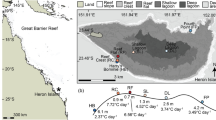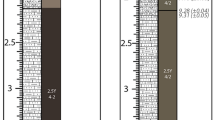Abstract
The development of a coral community was monitored for 6 years (1998–2004) on 46 m2 of artificial settlement substrate in Curaçao, Netherlands Antilles. Growth and survival of recruits (n=1385) belonging to 16 different species were quantified in relation to characteristics of the benthic community developing around them. The early life history dynamics (i.e. growth rate, growth strategy and survival) of corals differed among species although these differences were small for species occupying similar habitats (i.e. underside versus topside of substratum). In contrast to recruit survival, juvenile growth rates were highly variable and unrelated to benthic community structure, at least at the scale of this study. Competing benthic organisms affected coral recruitment success through space preemption (mainly by macroalgae) or recruit overgrowth (mainly by sponges). The results highlight the small spatial scale (mm–cm) at which the processes responsible for recruitment success or failure occur and emphasize the need to include such small-scale observations in studies of coral early life-phase dynamics.








Similar content being viewed by others
References
Aerts LAM, Van Soest RWM (1997) Quantification of sponge/coral interactions in a physically stressed reef community, NE Colombia. Mar Ecol Prog Ser 148:125–134
Babcock RC, Mundy CN (1996) Coral recruitment: consequences of settlement choice for early growth and survivorship in two scleractinians. J Exp Mar Biol Ecol 206:179–201
Bak RPM (1976) The growth of coral colonies and the importance of crustose coralline algae and burrowing sponges in relation with carbonate accumulation. Neth J Sea Res 10:285–337
Bak RPM (1977) Coral reefs and their zonation in the Netherlands Antilles. Stud Geol 4:3–16
Bak RPM, Engel MS (1979) Distribution, abundance and survival of juvenile hermatypic corals (Scleractinia) and the importance of life-history strategies in the parent coral community. Mar Biol 54:341–352
Bak RPM, Nieuwland G (1995) Long-term change in coral communities along depth gradients over leeward reefs in the Netherlands Antilles. Bull Mar Sci 56:609–619
Birkeland C (1977) The importance of rate of biomass accumulation in early successional stages of benthic communities to the survival of coral recruits. Proc 3rd Int Coral Reef Symp 1:15–21
Birkeland C, Rowley D, Randall RH (1981) Coral recruitment patterns at Guam. The reef and man. Proc 4th Int Coral Reef Symp 2:339–344
Bruno JF (1998) Fragmentation in Madracis mirabilis (Duchassaing and Michelotti): how common is size-specific fragment survivorship in corals? J Exp Mar Biol Ecol 230:169–181
Caley MJ, Carr MH, Hixon MA, Hughes TP, Jones GP, Menge BA (1996) Recruitment and the local dynamics of open marine populations. Ann Rev Ecol Syst 27:477–500
Carlon DB (2001) Depth-related patterns of coral recruitment and cryptic suspension-feeding invertebrates on Guana Island, British Virgin Islands. Bull Mar Sci 68:525–541
Connell JH (1973) Population ecology of reef-building corals. In: Jones OA, Endean R (eds) Biology and geology of coral reefs. Academic Press, London, pp 271–324
Connell JH, Hughes TP, Wallace CC (1997) A 30-year study of coral abundance, recruitment and disturbance at several scales in space and time. Ecol Monogr 67:461–488
Edmunds PJ (2000) Patterns in the distribution of juvenile corals and coral reef community structure in St. John, US Virgin Islands. Mar Ecol Prog Ser 202:113–124
Edmunds PJ, Carpenter RC (2001) Recovery of Diadema leads to reduced macroalgal cover and increased abundance of juvenile corals on a Caribbean reef. Proc Nat Acad Sci USA 98:5067–5071
Edmunds PJ, Bruno JF, Carlon DB (2004) Effects of depth and microhabitat on growth and survivorship of juvenile corals in the Florida Keys. Mar Ecol Prog Ser 278:115–124
Fenner D, Banks K (2004) Orange cup coral Tubastrea coccinea invades Florida and the flower Garden Banks, Northwestern Gulf of Mexico. Coral Reefs 23:505–507
Fitzhardinge RC (1988) Coral recruitment: the importance of interspecific differences in juvenile growth and mortality. Proc 6th Int Coral Reef Symp 2:673–678
Gilmour J (1999) Experimental investigation into the effects of suspended sediment on fertilisation, larval survival and settlement in a scleractinian coral. Mar Biol 135:451–462
Hughes TP, Jackson JBC (1985) Population dynamics and life histories of foliaceous corals. Ecol Monogr 55:141–166
Hughes TP, Connell JH (1987) Population dynamics based on size or age? A reef-coral analysis. Am Nat 129:818–829
Hughes TP, Connell JH (1999) Multiple stressors on coral reefs: a long-term perspective. Limnol Oceanog 44:932–940
Hughes TP, Tanner JE (2000) Recruitment failure, life histories, and long-term decline of Caribbean corals. Ecology 81:2250–2263
Hughes TP, Baird AH, Dinsdale EA, Moltschaniwskyj NA, Pratchett MS, Tanner JE, Willis BL (2000) Supply-side ecology works both ways: the link between benthic adults, fecundity, and larval recruits. Ecology 81:2241–2249
Jackson JBC, Buss L (1975) Allelopathy and spatial competition among coral reef invertebrates. Proc Nat Acad Sci USA 72:5160–5163
Maida M, Sammarco PW, Coll JC (1995) Effects of soft corals on scleractinian coral recruitment .1. Directional allelopathy and inhibition of settlement. Mar Ecol Prog Ser 121:191–202
McCook LJ (1999) Macroalgae, nutrients and phase shifts on coral reefs: scientific issues and management consequences for the Great Barrier Reef. Coral Reefs 18:357–367
McCook LJ, Jompa J, Diaz-Pulido G (2001) Competition between corals and algae on coral reefs: a review of evidence and mechanisms. Coral Reefs 19:400–417
Meesters EH, Wesseling I, Bak RPM (1996) Partial mortality in three species of reef-building corals (Scleractinia) and the relation with colony morphology. Bull Mar Sci 58:838–852
Miller MW, Hay ME (1996) Coral–seaweed–grazer–nutrient interactions on temperate reefs. Ecol Monogr 66:323–344
Miller MW, Hay ME (1998) Effects of fish predation and seaweed competition on the survival and growth of corals. Oecologia 113:231–238
MorganSG (2001) The larval ecology of marine communities. In: Bertness MD, Gaines SD, Hay ME (eds) Marine community ecology. Sinauer Associates, Sunderland, pp 159–181
Morse DE, Hooker N, Morse ANC, Jensen RA (1988) Control of larval metamorphosis and recruitment in sympatric agariciid corals. J Exp Mar Biol Ecol 116:193–217
Mundy CN, Babcock RC (1998) Role of light intensity and spectral quality in coral settlement: implications for depth-dependent settlement? J Exp Mar Biol Ecol 223(2):235–255
Mundy CN, Babcock RC (2000) Are vertical distribution patterns of scleractinian corals maintained by pre- or post-settlement processes? A case study of three contrasting species. Mar Ecol Prog Ser 198:109–119
Nugues MM, Delvoye L, Bak RPM (2004) Coral defence against macroalgae: differential effects of mesenterial filaments on the green algae Halimeda opuntia. Mar Ecol Prog Ser 278:103–114
Raimondi PT, Morse ANC (2000) The consequences of complex larval behavior in a coral. Ecology 81:3193–3211
Rogers CS, McLain LN, Tobias CR (1991) Effects of hurricane Hugo (1989) on a coral reef in St. John, USVI. Mar Ecol Prog Ser 78:189–199
Ruiz-Zárate MA, Arias-González JE (2004) Spatial study of juvenile corals in the Northern region of the Mesoamerican Barrier Reef System (MBRS). Coral Reefs 23:584–594
Sammarco PW (1980) Diadema and its relationship to coral spat mortality: grazing, competition and biological disturbance. J Exp Mar Biol Ecol 45:245–272
Sammarco PW, Carleton JH (1981) Damselfish territoriality and coral community structure: reduced grazing, coral recruitment, and effects on coral spat. The reef and man. Proc 4th Int Coral Reef Symp 2:525–535
Sebens KP (1982) Competition for space: growth rate, reproductive output, and escape in size. Am Nat 120:189–197
Tomascik T (1991) Settlement patterns of Caribbean scleractinian corals on artificial substrata along a eutrophication gradient, Barbados, West Indies. Mar Ecol Prog Ser 77:261–269
Van den Hoek C, Breeman AM, Bak RPM, Van Buurt G (1978) The distribution of algae, corals, and gorgonians in relation to depth, light attenuation, water movement and grazing pressure in the fringing coral reef of Curaçao, Netherlands Antilles. Aquat Bot 5:1–46
Van Duyl FC (1985) Atlas of the living reefs of Curaçao and Bonaire (Netherlands Antilles). Foundation for Scientific Research in Surinam and the Netherlands Antilles, Amsterdam, pp 1–37
Van Moorsel GWNM (1983) Reproductive strategies of two closely related stony corals (Agaricia, Scleractinia). Mar Ecol Prog Ser 13:273–283
Van Moorsel GWNM (1985) Disturbance and growth of juvenile corals (Agaricia humulis and Agaricia agaricites, Scleractinia) in natural habitats on the reef of Curaçao. Mar Ecol Prog Ser 24:99–112
Van Moorsel GWNM (1988) Early maximum growth of stony corals (Scleractinian) after settlement on artificial substrata on a Caribbean reef. Mar Ecol Prog Ser 50:127–135
Van Moorsel GWNM (1989) Juvenile ecology and reproductive strategies of reef corals. PhD thesis, University of Amsterdam, Amsterdam, pp 1–104
Vaughan TW (1919) Corals and the formation of coral reefs. Annu Rep Smithson Inst 17:189–238
Vermeij MJA, Bak RPM (2002) Corals on the move: rambling of Madracis pharensis polyps early after settlement. Coral Reefs 21:262–263
Vermeij MJA (2005a) Substrate composition and adult distribution determine recruitment patterns in a Caribbean brooding coral. Mar Ecol Prog Ser 295:123–133
Vermeij MJA (2005b) A novel growth strategy allows Tubastrea coccinea to escape adverse conditions and start over again. Coral Reefs; DOI: 10.1007/s00338-005-0489-z
Acknowledgements
I thank the Carmabi foundation and personnel for continuous help provided during this long-term project. Comments by Rolf Bak and Margaret Miller greatly improved earlier versions of this manuscript.
Author information
Authors and Affiliations
Corresponding author
Additional information
Communicated by Ecological Editor P.J. Mumby
Rights and permissions
About this article
Cite this article
Vermeij, M. Early life-history dynamics of Caribbean coral species on artificial substratum: the importance of competition, growth and variation in life-history strategy. Coral Reefs 25, 59–71 (2006). https://doi.org/10.1007/s00338-005-0056-7
Received:
Accepted:
Published:
Issue Date:
DOI: https://doi.org/10.1007/s00338-005-0056-7




